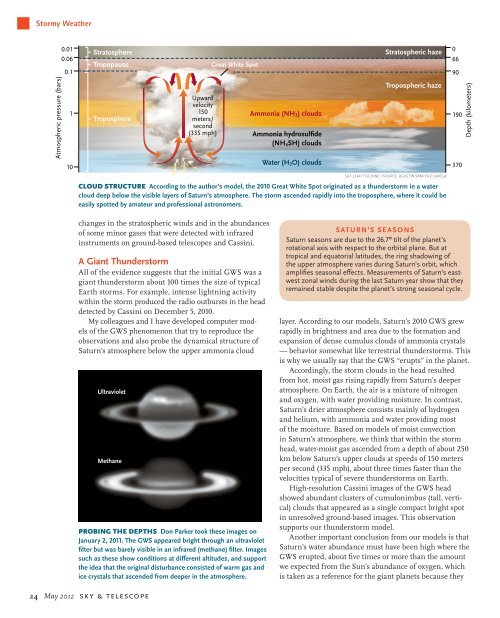Download this ebook as PDF - E-Book Library
Download this ebook as PDF - E-Book Library
Download this ebook as PDF - E-Book Library
You also want an ePaper? Increase the reach of your titles
YUMPU automatically turns print PDFs into web optimized ePapers that Google loves.
Stormy Weather<br />
0.06<br />
0.1<br />
1<br />
Atmospheric pressure (bars) 0.01<br />
10<br />
Stratosphere<br />
Tropopause<br />
Troposphere<br />
Upward<br />
velocity<br />
150<br />
meters/<br />
second<br />
(335 mph)<br />
Great White Spot<br />
changes in the stratospheric winds and in the abundances<br />
of some minor g<strong>as</strong>es that were detected with infrared<br />
instruments on ground-b<strong>as</strong>ed telescopes and C<strong>as</strong>sini.<br />
A Giant Thunderstorm<br />
All of the evidence suggests that the initial GWS w<strong>as</strong> a<br />
giant thunderstorm about 100 times the size of typical<br />
Earth storms. For example, intense lightning activity<br />
within the storm produced the radio outbursts in the head<br />
detected by C<strong>as</strong>sini on December 5, 2010.<br />
My colleagues and I have developed computer models<br />
of the GWS phenomenon that try to reproduce the<br />
observations and also probe the dynamical structure of<br />
Saturn’s atmosphere below the upper ammonia cloud<br />
Ultraviolet<br />
Methane<br />
PROBING THE DEPTHS Don Parker took these images on<br />
January 2, 2011. The GWS appeared bright through an ultraviolet<br />
fi lter but w<strong>as</strong> barely visible in an infrared (methane) fi lter. Images<br />
such <strong>as</strong> these show conditions at diff erent altitudes, and support<br />
the idea that the original disturbance consisted of warm g<strong>as</strong> and<br />
ice crystals that <strong>as</strong>cended from deeper in the atmosphere.<br />
24 May 2012 sky & telescope<br />
Ammonia (NH3) clouds<br />
Ammonia hydrosulfide<br />
(NH4SH) clouds<br />
Water (H2O) clouds<br />
Stratospheric haze<br />
Tropospheric haze<br />
S&T: LEAH TISCIONE / SOURCE: AGUSTÍN SÁNCHEZ-LAVEGA<br />
CLOUD STRUCTURE According to the author’s model, the 2010 Great White Spot originated <strong>as</strong> a thunderstorm in a water<br />
cloud deep below the visible layers of Saturn’s atmosphere. The storm <strong>as</strong>cended rapidly into the troposphere, where it could be<br />
e<strong>as</strong>ily spotted by amateur and professional <strong>as</strong>tronomers.<br />
0<br />
66<br />
90<br />
190<br />
370<br />
SATURN’S SEASONS<br />
Saturn se<strong>as</strong>ons are due to the 26.7° tilt of the planet’s<br />
rotational axis with respect to the orbital plane. But at<br />
tropical and equatorial latitudes, the ring shadowing of<br />
the upper atmosphere varies during Saturn's orbit, which<br />
amplifi es se<strong>as</strong>onal eff ects. Me<strong>as</strong>urements of Saturn’s e<strong>as</strong>twest<br />
zonal winds during the l<strong>as</strong>t Saturn year show that they<br />
remained stable despite the planet’s strong se<strong>as</strong>onal cycle.<br />
layer. According to our models, Saturn’s 2010 GWS grew<br />
rapidly in brightness and area due to the formation and<br />
expansion of dense cumulus clouds of ammonia crystals<br />
— behavior somewhat like terrestrial thunderstorms. This<br />
is why we usually say that the GWS “erupts” in the planet.<br />
Accordingly, the storm clouds in the head resulted<br />
from hot, moist g<strong>as</strong> rising rapidly from Saturn’s deeper<br />
atmosphere. On Earth, the air is a mixture of nitrogen<br />
and oxygen, with water providing moisture. In contr<strong>as</strong>t,<br />
Saturn’s drier atmosphere consists mainly of hydrogen<br />
and helium, with ammonia and water providing most<br />
of the moisture. B<strong>as</strong>ed on models of moist convection<br />
in Saturn’s atmosphere, we think that within the storm<br />
head, water-moist g<strong>as</strong> <strong>as</strong>cended from a depth of about 250<br />
km below Saturn’s upper clouds at speeds of 150 meters<br />
per second (335 mph), about three times f<strong>as</strong>ter than the<br />
velocities typical of severe thunderstorms on Earth.<br />
High-resolution C<strong>as</strong>sini images of the GWS head<br />
showed abundant clusters of cumulonimbus (tall, vertical)<br />
clouds that appeared <strong>as</strong> a single compact bright spot<br />
in unresolved ground-b<strong>as</strong>ed images. This observation<br />
supports our thunderstorm model.<br />
Another important conclusion from our models is that<br />
Saturn’s water abundance must have been high where the<br />
GWS erupted, about fi ve times or more than the amount<br />
we expected from the Sun’s abundance of oxygen, which<br />
is taken <strong>as</strong> a reference for the giant planets because they<br />
Depth (kilometers)


